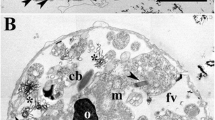Abstract
Toxothrix trichogenes (Chol.) Beger et Bringmann was found in iron-containing spring water, in tap water, and in a small forest pond of lower Michigan.
The use of a partially submerged microscope for continuous observation of undisturbed underwater “Aufwuchs” on glass slides resulted in the rediscovery of the actualToxothrix organisms: long, often U-shaped and highly flexible bacterial filaments. Direct observation of their growth and movements on immersed glass slides revealed the production byToxothrix trichomes of several slime strands which were typically twisted. Fan-shaped slime structures and parallel tracks were directly seen to be formed by U-shaped organisms as a result of the forward gliding and rolling of their center portion. Chemical iron deposition onto the individual slime strands of such tracks rendered these rigid and brittle; the iron deposition also proceeded in the absence of living trichomes.
The trichomes disintegrated rapidly and completely during laboratory observations, althoughToxothrix trichomes were kept viable for several months in refrigerated state. Disintegration under the normal light microscope explains their absence from most stranded “sheaths” studied by previous investigators.
Similar content being viewed by others
References
Aleem, M. I. H. andShort, S. A. 1968. Electron-transport mechanisms in the chemoautotrophFerrobacillus Ferrobacillus ferrooxidans. - Bacteriol. Proc.1968: 140.
Balashova, V. V. 1967. Structure of the stalk fibers in a laboratory culture ofGallionella filamenta. - Mikrobiologiya36: 1050–1053 (Russian).
Balashova, V. V. 1969. Taxonomy of the genusGallionella. - Mikrobiologiya37: 715–723 (Russian).
Beger, H. andBringmann, G. 1953. Die Scheidenstruktur des AbwasserbakteriumsSphaerotilus und des EisenbakteriumsLeptothrix im elektronenmikroskopischen Bilde und ihre Bedeutung für die Systematik dieser Gattungen. - Zentralbl. Bakt. II. Abt.107: 318–334.
Breed, R. S. andBeger, H. 1957. Chlamydobacteriales.In Bergey's Manual of determinative bacteriology, VIIth Ed. - Williams and Wilkins, Baltimore.
Cholodny, N. 1924. Über neue Eisenbakterienarten aus der GattungLeptothrix Kütz. - Zentralbl. Bakt. II. Abt.61: 292–298.
Cholodny, N. 1926. Die Eisenbakterien. Beiträge zu einer Monographie. - Pflanzenforschg. Heft 4, G. Fischer, Jena.
Engel, H. andHanert, H. 1967. Isolierung vonGallionella Ehruginea Ehrenberg. - Naturwissenschaften54: 147.
Hanert, H. 1968. Untersuchungen zur Isolierung, Stoffwechselphysiologie und Morphologie vonGallionella ferruginea Ehrenberg. - Arch. Mikrobiol.60: 348–376.
Hässelbarth, U. andLüdemann, D. 1967. Die biologische Verockerung von Brunnen durch Massenentwicklung von Eisen- und Manganbakterien. - Bohrtechnik-Brunnenbau-Rohrleitungsbau 10/11 (Bericht a.d. DVGW-Fachausschuss “Wasserfassung u. Wasseranreicherung”).
Hirsch, P. 1968. Biology of budding bacteria. IV. Epicellular deposition of iron by aquatic budding bacteria. - Arch. Microbiol.60: 201–216.
Holt, J. G. andLewin, R. A. 1968.Herpetosiphon aurantiacus gen. et sp.n., a new filamentous gliding organism. - J. Bacteriol.95: 2407–2408.
Leathen, W. W., Kinsel, N. A. andBraley, S. A., Sr. 1956.Ferrobacillus ferrooxidans, a chemosynthetic, autotrophic bacterium. - J. Bacteriol.72: 700–704.
Molisch, H. 1925. Botanische Beobachtungen in Japan. VIII. Mitteilung. Die Eisenorganismen in Japan. - Science Reports, Tohoku Imp. Univ., 4. Ser., Biology, 135–168.
Pringsheim, E. G. 1949. Iron bacteria. - Biol. Rev. Cambridge Phil. Soc.24: 200–245.
Silverman, M. P. andLundgren, D. G. 1959. Studies on the chemoautotrophic iron bacteriumFerrobacillus ferrooxidans. I. An improved medium and a harvesting procedure for securing high cell yields. - J. Bacteriol.77: 642–647.
Staley, J. T. 1969. In situ microscopic observations of the growth of algae. - Bacteriol. Proc.1969: 25–26.
van Iterson, W. 1958.Gallionella ferruginea Ehrenberg in a different light. - Verh. Kon. Ned. Akad. v. Wetensch., Afd. Natuurk, Reeks 2,42, Nr. 2, 1–185.
Author information
Authors and Affiliations
Additional information
Agricultural Experiment Station Article No. 4935.
The investigations were supported by an NSF Institutional Grant for Science to J. T. Staley and by the Michigan State University, Agricultural Experiment Station. J. M. Krul acknowledges gratefully a travel grant from the Ministerie van Landbouw en Visserij. We are thankful for the interest in and help with this work by Dr. G. Lauff, Kellogg Biological Station (Hickory Corners, Mich.) and Mr. W. A. Lemmien, MSU Experimental Forest, Augusta, Mich. Dr. G. A. Zavarzin, Moscow, contributedToxothrix samples and helped with his interest and discussions.
MSU Kellogg Biological Station Contribution No. 189
Rights and permissions
About this article
Cite this article
Krul, J.M., Hirsch, P. & Staley, J.T. Toxothrix trichogenes (Chol.) Beger et Bringmann: The organism and its biology. Antonie van Leeuwenhoek 36, 409–420 (1970). https://doi.org/10.1007/BF02069041
Received:
Issue Date:
DOI: https://doi.org/10.1007/BF02069041




